You all know how much I’ve always loved booking races as an excuse to go somewhere new and fun, but this summer, I discovered a new love — the inn-to-inn walking holiday.
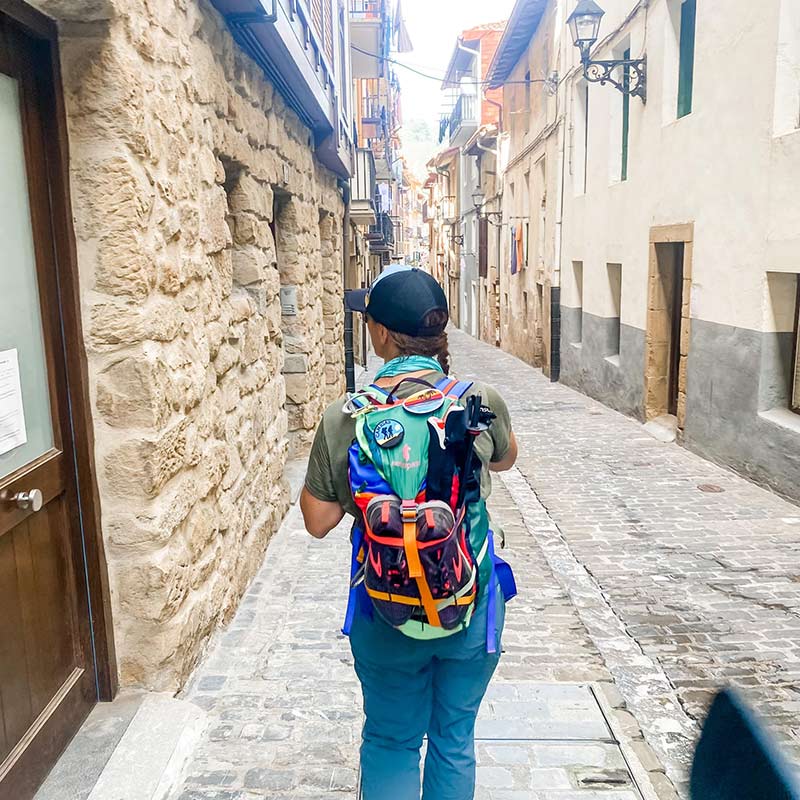
Strolling into Getaria at the end of an epic first day.
Long story short, my husband (you all know Jared, right?) and I had an opportunity to go to Spain — specifically, to San Sebastián. And, once I saw where we’d be, I began looking into cool hiking opportunities in the area. As it turned out, San Sebastián was right on the path of the Camino del Norte, which is one of several routes of the Camino de Santiago, an historic pilgrimage with medieval origins that leads to what’s believed to be the tomb of the Apostle Saint James the Greater, located in the crypt of the Santiago de Compostela Cathedral.
Now, the full Camino del Norte is a little over 500 miles, and many people take several weeks or even a couple of months to walk the full route, carrying all their belongings and staying in albergues (hostels) or camping wherever they end up each day.
That wasn’t quite how we approached it, though, for a few reasons.
For starters, we only had about a week, plus we knew we wanted guaranteed beds in private rooms — so we decided to use a service (Macs Adventure) to book accommodations ahead of time and arrange for our luggage to be transferred. That allowed us to carry just the essentials for each day’s hike (water, first aid, snacks, layers) in day packs.
Even so, we knew the trek would be no joke. We’d be walking for six consecutive days with planned daily distances ranging up to 16-plus miles, climbing and descending between close to 1500 and 3000 feet each day. Keep in mind, we live in Florida — it’s flat, for one thing, and for much of the year it’s so hot that, frankly, we don’t do a ton of walking to get places. So, Jared and I took the training and planning for this adventure seriously to make sure we were physically up for the task, understood what to expect from a cultural perspective in these small Spanish towns, and had the right gear to get the job done.
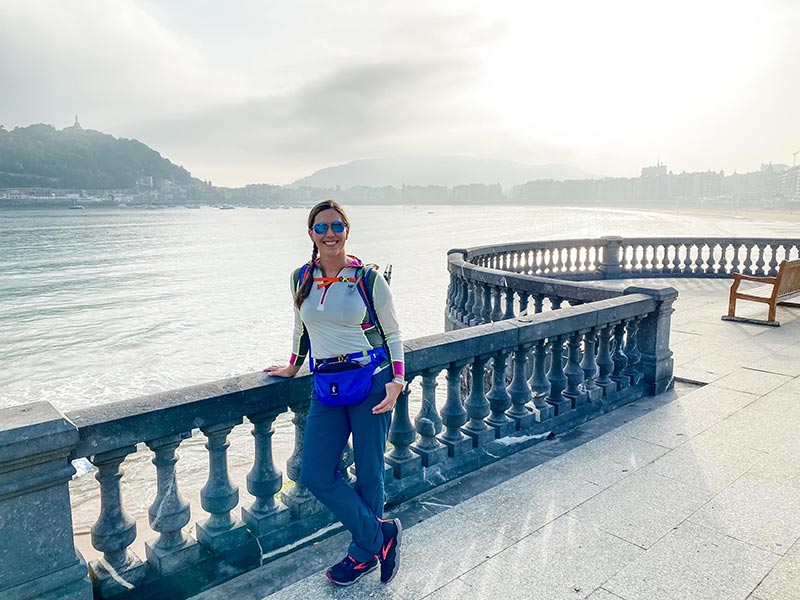
At the start of Day 1, on the walk out of San Sebastian, I thought I might need long sleeves. I was wrong — but hey, I looked cute to begin with!
Long story short — we absolutely loved our experience on the Camino. We ended up shorting two days by a few miles due to a freak heat wave (and fortunately, it was easy to grab a bus or taxi in those cases), but still ended up with over 70 miles over the six days … and we totally could’ve kept going. (I wanted to keep going, actually.) Part of our preparedness was certainly due to the fact that we spent many Saturday and Sunday mornings in the months leading up to the trip walking all around town and exploring every local trail to get miles in. But, having the right gear, both for the training and the trip, also made a big difference.
Now, I’m happy to answer any questions you all might have about the trip itself (just leave a comment on Insta!), but I fielded a lot of questions about gear and clothes as I prepared, so I figured it might be helpful to share what Jared and I used while training and on the Camino itself.
Let me be clear — you can ABSOLUTELY do this (or something similar) with whatever gear you have and love. You certainly don’t need to spend a fortune shopping, and you’re better off wearing items that are proven, if a little worn, vs. something just out of the box. But, for those who are in the market for a few new goodies, the list below is a mix of items I received from brands to review and things we purchased, but anything included here is only here because I would recommend it — none of this is sponsored or otherwise required.
Camino-Ready Clothing
First up, let’s talk clothes. You’ve probably heard enough by now about my beloved Clamberista pants from Title Nine (which are now sold out, although they have a Recycled Clamber 2.0 available); I wore these on a couple of days, but because it was so much warmer than usual for the area, I was psyched to have also packed the Switchback Ultralight Hiking Skort. It’s comfortable, ridiculously lightweight, it dries quickly, and the built-in shorts liner prevents chafing. Only downside is that it runs a little big, so even with the drawstring waist, putting anything weighty (like a phone) in the pockets dragged it down a bit. Title Nine also offers shorts and joggers in the same lightweight material, which I’m thinking I may need to check into before my next hiking adventure …
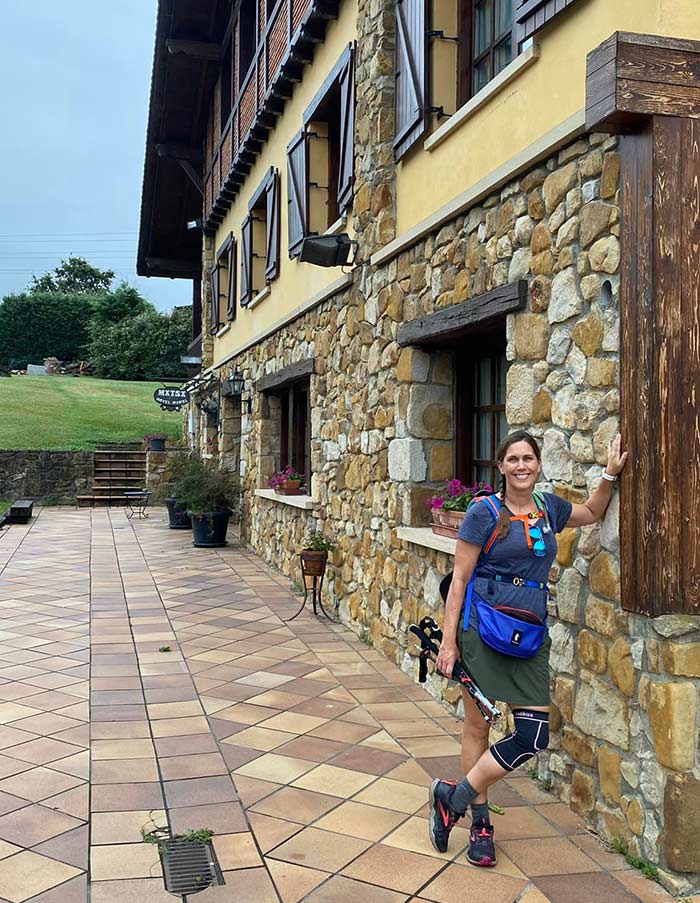
Sporting my old Icebreaker tee, my new Title Nine skort and Brooks Caldera 5 shoes, and ready to tackle our final day of hiking into Bilbao.
KUHL ended up being a go-to for both Jared and me, both in training and on the trip. I put in a lot of miles wearing the quick-drying, slightly stretchy Trekr Short; I went with the 8″ option, although it’s also available in a 5.5″ and 11″. If in doubt on this one, I’d probably order a size up since there’s an internal drawstring at the waist and belt loops. When it came to tops, we both wore a lot of Merino wool since it’s naturally moisture-wicking and odor-resistant. I have this Cashmerino tee (size down if you’re between two sizes), and Jared ended up liking the look of this Valiant short sleeve shirt so much that, in Spain he saved it to wear out to dinner. Most days on the trail, he wore a Saxx Hot Shot tee, which has cooling technology and, even when he rinsed it out completely at night, it was always fully dry by morning. I also sported an old (like, many years old) Icebreaker Merino tee (it’s not this one, I don’t think but it’s similar) and this ibex Merino Tencel tee, which was super comfortable (and I liked that it wasn’t super long) but, by the end of the walk, had pilled pretty badly where my backpack rubbed on it — bummer.
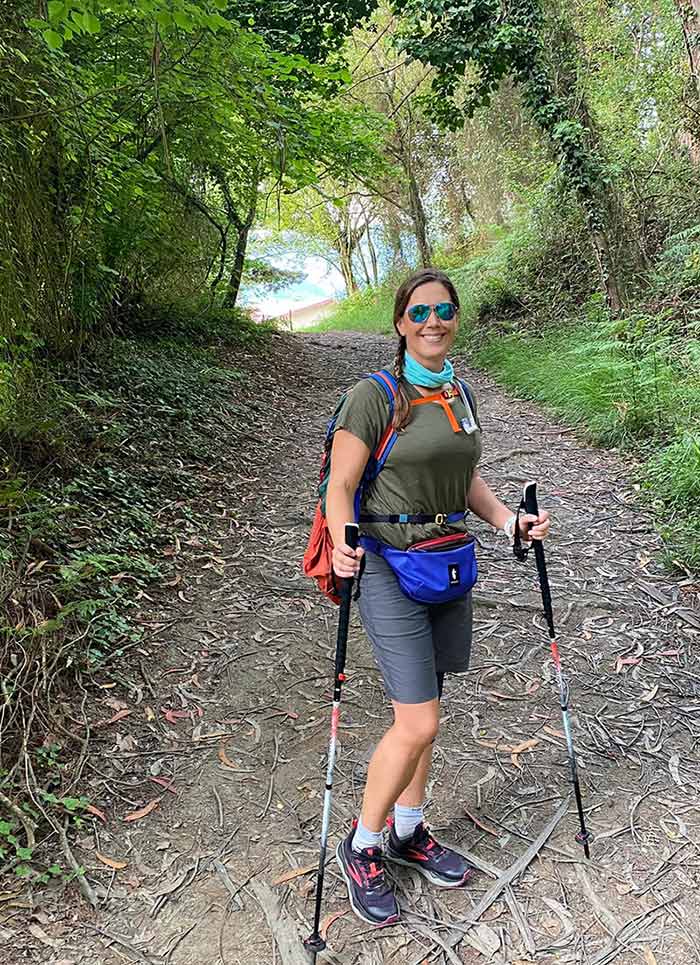
Even on the flatter parts, the trekking poles were GREAT. And so were these KUHL shorts.
Speaking of Merino wool, I’ve gotta give a shout out to Smartwool; I had two of their wool blend sports bras and a cuple pairs of their undies that I switched between on the hike. Now, I won’t lie — the bras were not quite as odor-resistant as I’d hoped they’d be, but then again, I sweated a LOT, so having to wash them in the sink a couple of times seemed pretty fair … even if I did have to hang them from my backpack the next morning so they’d finish drying. (And that’s why you only wash one at a time, kids.)
And, although it ended up being too hot out to keep it on for long while hiking, I was happy to have this Kari Traa Voss Light Half Zip Top on hand for a couple of cooler mornings; it’s made with a Merino wool blend, is nicely stretchy, and feels super soft and light. I also brought along the Voss Hybrid Hiking Leggings; they were great for a marathon travel day, but were a little warmer than I needed for this particular hike.
Footwear for Miles
Spend more than 30 seconds on any Camino (or multi-day trekking route) forum and you’ll find all kinds of footwear thoughts, but, from what I can tell, the best plan comes down to the following:
- Choosing the right type of shoes and socks for the route you’re on.
- Training (a lot) in the exact shoe/sock combination you plan to wear on your trip.
- Taking plenty of breaks during your hike, changing socks and treating blisters immediately if needed.

The yellow arrows and shell are the symbols of the Camino, and while some signs are permanent and formal like this, a lot of the time, it’s a yellow spray painted arrow on wood or stone.
Because the Camino del Norte isn’t terribly technical and there was a lot of time on paved trails, I opted for trail runners instead of hiking boots; specifically, I went with the Brooks Caldera 5 since I’ve been wearing Calderas on trails for years, but — here’s the catch — I went up a full size from my usual to allow for layered socks and swollen feet. (Lucky for me, I also had a chance to bring along the brand new Caldera 6 in a half size up, which I wore for casual walks around town; I’ll probably opt for those in a full size up when I do my next multi-day trek, because they are sweeeeet and I got a million compliments on them.) I brought along my trusty xero shoes Z-Trail sandals as alternates, too, switching into those when we ended up on some of the longer, flatter sections.
Jared, on the other hand, wanted a waterproof option, and after trying on many, many options at REI, he opted for the Salomon X Ultra, also going a size up, and he was really pleased with his choice, too.
For both of us, I think the sock game was just as important as our shoe choice. We used the Injinji sock liners beneath a variety of midweight wool socks religiously (Darn Tough, Smartwool), and although I did end up with some minor blisters on the outside of my big toes, neither of us experienced any of the dreaded between-the-toe blisters, which can really screw up your hike. (For the blisters I did experience, a Band-Aid Hydro Seal Blister Cushion, fully covered with a layer or two of KT tape, worked well to keep them from rupturing or getting worse.)
Other Key Gear
First and foremost, I’ve gotta talk about trekking poles. If you have any knee (or ankle, hip, back, etc.) issues, I highly, highly recommend bringing trekking poles on your next hike. They take loads of pressure off your knees and other joints, especially on downhills or technical terrain, they give you a little extra power on the steep uphills, and — here’s the thing that seems to surprise people — using them, even on flat, level ground, keeps your hands and fingers from swelling up. Seriously, over 70 miles and no hot dog fingers over here! I used the TSL Connect Carbon 5 Trekking Poles, which I loved because they’re easy to adjust, simple to break down when not in use, and have multiple options for tips. The handle was comfortable, the wrist straps easily adjusted on the fly … I will not be hiking without them in the future. Jared, once an avowed “I’ll just find a stick at the trailhead “guy, is also a convert, and he used the Black Diamond Distance Z Trekking Poles with zero complaints.
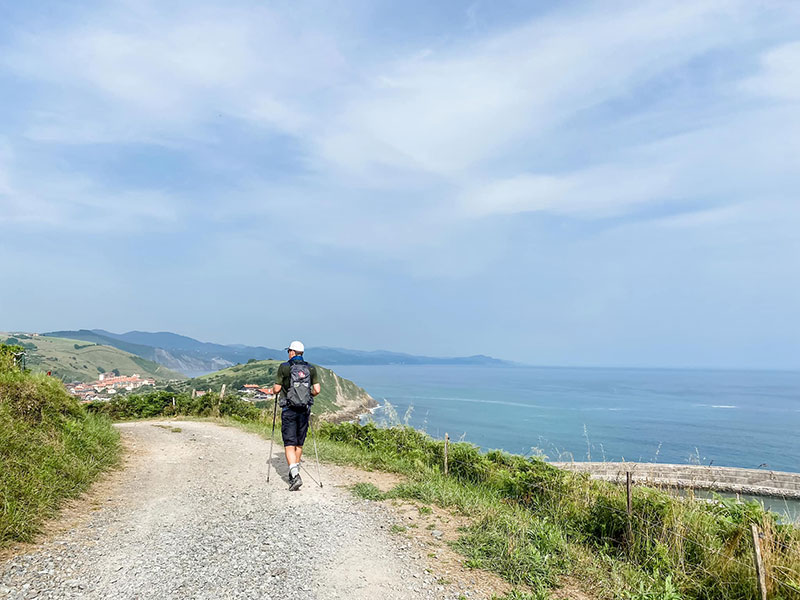
This view of the Cantabrian Sea as we headed toward Zumaia, en route to Deba, was a real highlight.
Obviously, our packs were pretty important. Jared had picked up an Osprey Talon 22 last summer when we hiked in Colorado, and that was a perfect daypack for this trip. I carried the 20L Cotopaxi Tarak, which was super comfortable and had plenty of room for a 3L water bladder and everything else I needed, but after a couple of days on the trail, I realized that the design (basically one large compartment with just a couple of small outer zippers and one tiny interior pocket) didn’t make access as easy as Jared’s pack did. Which is fair — my pack was designed to be no-frills, and is really more for climbers and skiers than someone like me. I carried this Coso 2L Hip Pack in addition, which allowed me to have my phone/camera, snacks, and multitool super handy.
And, speaking of a multitool … well, I didn’t end up needing to use it much, but I was still happy to have Leatherman Signal at the ready. It’s not the most lightweight multitool, but, I mean, it packs a hammer, one-handed blade, emergency whistle, a dang firestarter, and like 15 more things into a tiny little package. Since we only had daypacks, adding a couple extra ounces to have all that available seemed like a smart move.
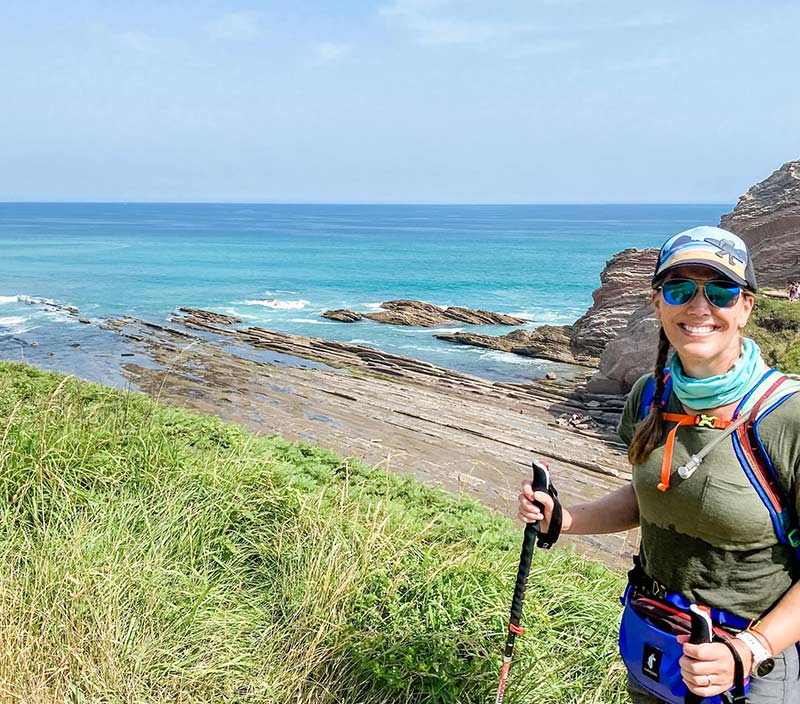
Just out of Zumaia, on an alternate route, you get this view of the Basque Geopark, and it was even more stunning in person — which made the tough climb to get there worth it.
Because there was so much sun exposure, we always kept our Buffs on our necks (sometimes after wetting them in a fountain to help cool us off), and generally wore ball caps in addition to loads of sunscreen. We’d toyed with getting proper sunhats, and will probably add those to the list next time, but we got through the week without too much red skin.
And, although we ended up not needing to use it on the trail, we did have rain gear; a Mammut Albula HS Hooded Jacket and some bright yellow rain pants I found on sale for me, and, for Jared, the North Face Alta Vista Jacket (which had more venting than mine — perhaps not a bad thing for physical activity, I’m thinking).
Now, how much information is too much? Let’s find out. Okay, so I don’t have a problem peeing in the woods — I’ve squatted in more forests than I can count. And, in many of those cases, I’ve used a Kula Cloth to avoid having to pack out any TP, which is rad. But, I knew that there were some sections of the Camino that A) didn’t provide loads of tree or brush cover and B) could be pretty heavily trafficked, so the idea of baring my whole booty to the world … well, I figured that, if I could figure out a way to avoid that, then cool. So, I got myself a Shewee, which allows women (and anyone else without the equipment that lets you aim) to urinate while standing — and without having to fully drop their pants. I will definitely co-sign on their advice to practice using it ahead of time, ideally in the shower, and then probably on a few low-stakes occasions while wearing your hiking clothes.
Now, I’ve got two questions for you all to answer on Insta. First, what’s your favorite must-have hiking gear? And second, have you ever considered an inn-to-inn walking holiday like the Camino de Santiago? Would love to hear where you’ve been (and whether I should go there next!). I’m kind of thinking about Tour du Mont Blanc, but a little worried that might be biting off more than I’m ready to chew. —Kristen

